KLYUCHEVSKAYA SOPKA - THE HIGHEST VOLCANO OF EURASIA
Klyuchevskaya Sopka is the most famous in Russia and the highest active volcano in Eurasia, located on Far East country. The Kamchatka River - the largest on the peninsula of the same name - bends around it, turning to the east. The Klyuchevskaya Sopka stratovolcano was formed in the Holocene, about 7 thousand years ago. The volcano is a cone gigantic composed of flows of basaltic, partly andesitic lava. Those who come to admire the Klyuchevskaya Sopka are struck by this aesthetically correct cone, which looms against the background of the blue sky. From the side it seems that the volcano rises in splendid isolation, but upon closer examination it turns out that it merges with the neighboring volcanoes Kamen, Ploskaya Blizhnyaya and Ploskaya Dalnyaya.
The summit of Klyuchevskaya Sopka and neighboring volcanoes is covered with a common cover of three dozen glaciers, from which powerful ice tongues up to 20 km long descend. The cone of Klyuchevskoy Sopka is covered with barrancos - deep grooves extending from top to bottom and narrowing closer to the base of the volcano. A distinctive feature of Klyuchevskoy Sopka is that a column of smoke constantly rises above the main crater, frequent explosions with the release of bombs and ash occur in the crater, fumaroles and solfatars are active on the slopes. It is generally accepted that the height of the volcano is 4750 m, but depending on the power of the eruption, its height varies within a hundred meters, rising to a level of 4850 m and higher. According to the latest data, from the day last eruption- August 15, 2013 - its height is 4835 m, but at any moment it may decrease. At the foot of the volcano there are coniferous forests (there are most of them here within Kamchatka), mainly represented by Okhotsk larch and ayan spruce.
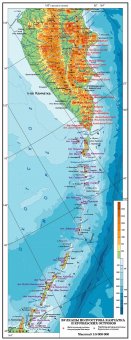
The first settlements in the area of Klyuchevskaya Sopka date back to the Stone Age, when Kamchatka was inhabited by Koryaks, Ainu and Itelmen. There is evidence that people appeared here earlier, in the early Neolithic era. The main occupation of the local population has always been hunting and fishing. Since the 17th century. Russians begin to develop Kamchatka. Having discovered springs with clean spring water in the vicinity of the volcano, the Russian pioneers founded the village of Klyuchi here and named the volcano Klyuchevskaya Sopka and the river Klyuchevka after it. The first mention of the volcano Kamchatka Mountain belongs to the Russian explorer Vladimir Atlasov (about 1661 / 1664-1711) - the discoverer of Kamchatka - and refers to 1697-1698. The first to conquer Klyuchevskaya Sopka was naval officer Daniil Gauss, who in 1788 arrived in Kamchatka as part of the Russian expedition of Captain Joseph Billings (1761-1806).
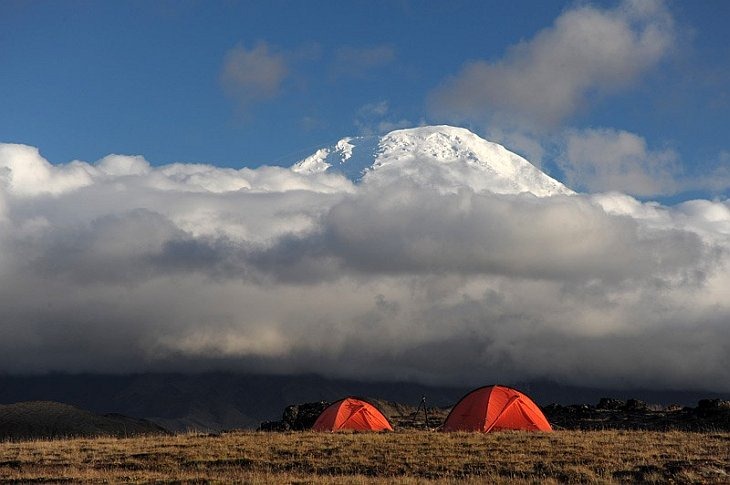
Accompanied by two companions, whose names remained unknown, he climbed the slope of the volcano to the very top. Climbing without special equipment and proper experience was extremely risky, Gauss described it later: “... I expected to find my grave at every step, and, immersed in deep thought, I surrendered to the will of the Almighty. My curiosity carried me all the way to the top of the mountain to see the crater itself and give the offspring an interesting description ... ".
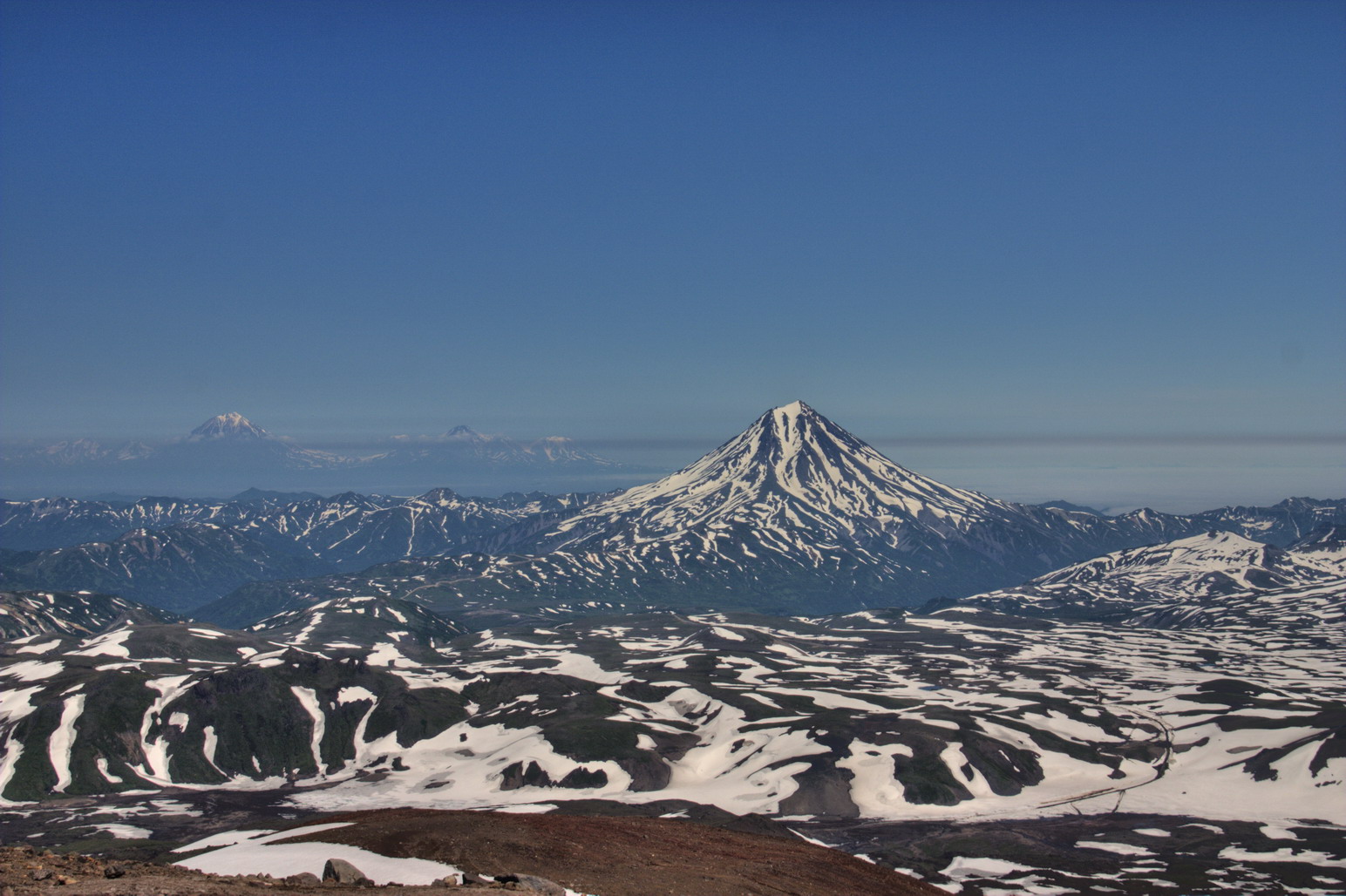
Add to List World heritage UNESCO includes six zones under the general name "Volcanoes of Kamchatka", and among them - Klyuchevskoy nature Park regional significance... Klyuchevskaya Sopka is an active volcano on the Kamchatka Peninsula. Located in the Klyuchevskaya group of volcanoes. It is located in the middle of the Kamchatka River valley. At the foot of Klyuchevskaya Sopka in the village of Klyuchi there is a volcanological station of the Institute of Volcanology of the Siberian Branch of the USSR Academy of Sciences. Locals They say that Klyuchevskaya Sopka is the home of the dead, and they say that the volcano erupts when the dead drown their yurts with the bones of whales that are caught in the underground sea. The activity of Klyuchevskaya Sopka has been monitored since 1697, for the first time the eruption of this volcano was described by Stepan Krasheninnikov, a member of the Second Kamchatka Expedition ... Long-term observations of the behavior of the volcano made it possible to find out that, as a rule, Klyuchevskaya Sopka erupts once every five to six years, and the most powerful eruptions occur once every quarter of a century.
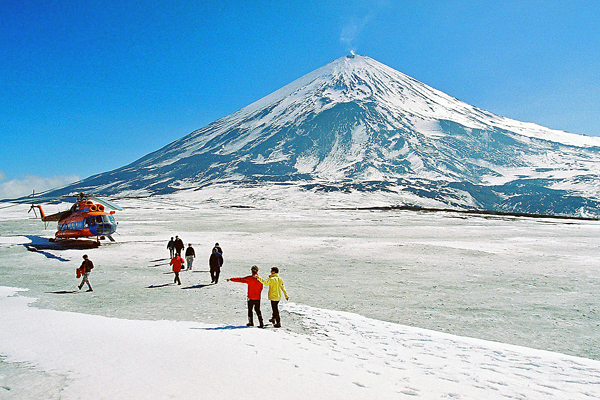
In the past three centuries, more than 50 strong eruptions, sometimes very powerful, have occurred on Klyuchevskaya Sopka. During a volcanic eruption, ash, smoke and gas rise to a height of 20 km, and ash, settling, scatters throughout the Eastern Hemisphere. 1727-1731, when the flame above the crater did not disappear for three consecutive years. So, during the strongest eruption of 1853, huge lava flows descended down the Kamchatka valley and reached the villages on the river. In 1932, the first side eruption in the history of the volcano's study took place (outside the main crater). During the eruption of 2004-2005. the column of ash rose to a record height for Klyuchevskaya Sopka - 8000 m.
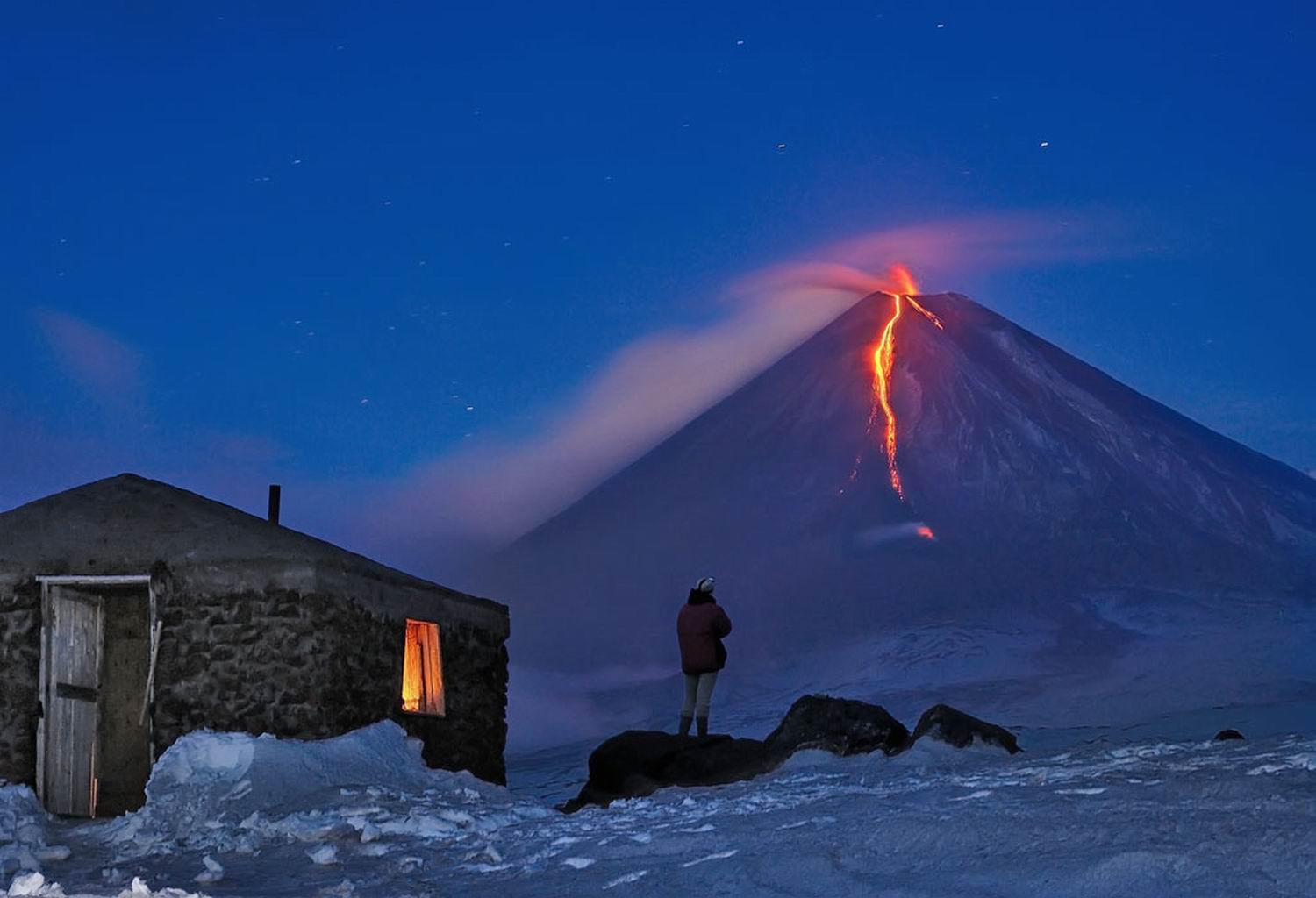
The last eruption of Klyuchevskaya Sopka was recorded on August 15, 2013. In the immediate vicinity of the volcano, at a distance of 30 km, there is only one village - Klyuchi, founded on the site of the large fort Nizhnekamchatsk - one of the first Russian Cossack forts in Kamchatka. The village is surrounded by mountains and forests inhabited by brown bears and lynxes. In 1731, it was completely burned during the Kamchadal revolt against excessive tax duty and restored in 1741. In Klyuchi, in 1935, the Kamchatka volcanological station of the Institute of Volcanology of the Far Eastern Branch of the Russian Academy of Sciences was opened, and since then constant regime observations have been carried out here. behind the volcanoes of the entire Klyuchevskaya group. The local population is engaged in gardening, cattle breeding and fishing. But even the distance from the volcano does not save from the consequences of eruptions - it is so great and powerful.
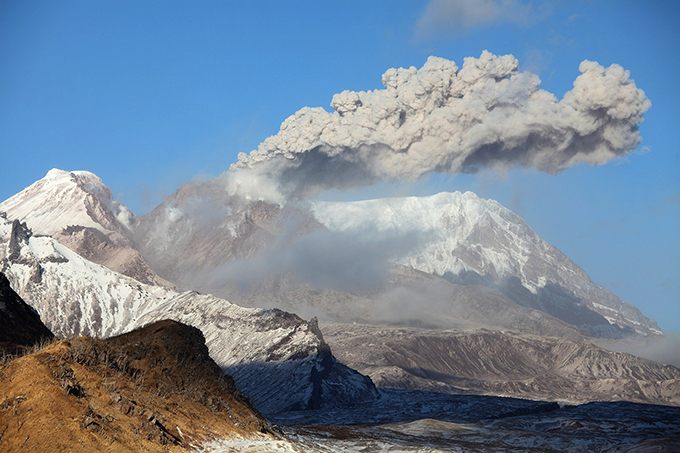
In 2010, an eruption of Klyuchevskaya Sopka took place, ash falls began, and the village of Ust-Kamchatsky, located 150 km from the volcano, was almost completely filled up. There are many people who want to admire the Klyuchevskaya Sopka, many are attracted by the opportunity to witness an unusual atmospheric phenomenon. Sometimes a strange cloud forms over the volcano, similar to a wide cone, covering the top of the volcano like a mushroom cap. The phenomenon arouses keen interest of ufologists, but it is explained by completely earthly reasons: it is a biconvex cloud, better known as a "cloud-cap". It arises from the accumulation of streams of moist air at the top. Tourists are always warned about safety measures: the insidious Klyuchevskaya Sopka confidently holds first place among other Kamchatka mountains in terms of the number of deaths on its slopes.
The ideally symmetrical snow-covered "Fire Mountain" is not only the highest active volcano in Eurasia, it is also the most active. From the very beginning of its functioning to the present day, not a single long period of its decay is known. The truncated cone of Klyuchevskaya Sopka rises on the slopes of an ancient extinct volcano. 340 km 3 of ash and lava have accumulated here in just 50 thousand years, which have passed since the last interglacial epoch. Diameter foundations Klyuchevskoy volcano is about 15 km, the diameter of the crater is 550–600 m, the steepness of the slopes is 32–33 degrees.
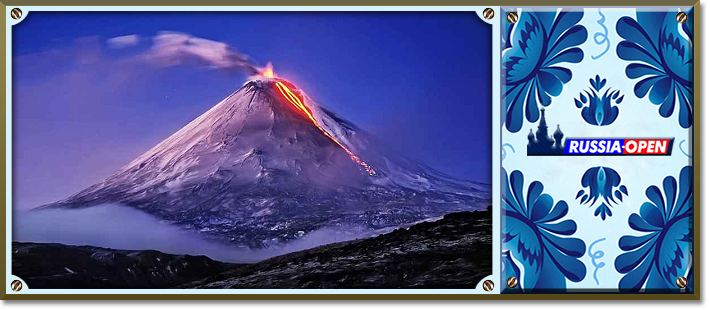
Eruptions occur both in the form of explosions and in the form of outpourings. The slopes of the volcano are covered with numerous cones and craters, formed by more than 100 slope eruptions over the past 3000 years. However, most of the eruptions originate from a summit crater with a diameter of 550-600 m.
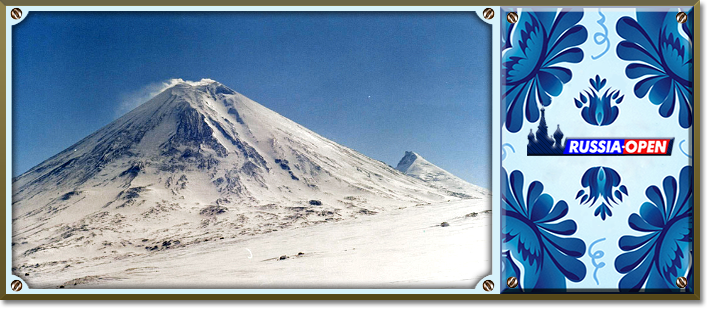
The height of Klyuchevskaya Sopka - 4,850 meters, may change with the next eruption. Since the last time the volcano spoke menacingly in 2009, its height has even approached the round figure of 5,000 meters.
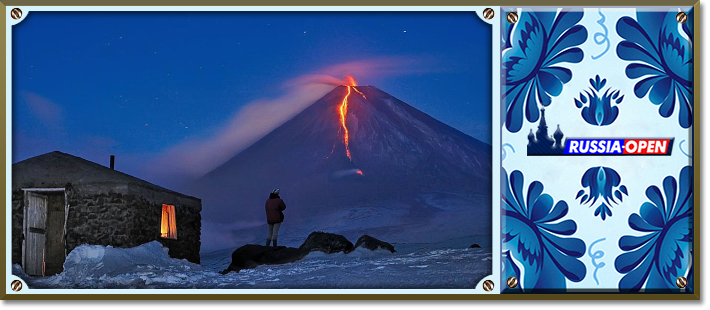
"Fire-breathing region" - Kamchatka - is located at the junction of two large tectonic plates, the Eurasian and Pacific ones, the movements of which cause volcanic processes. On east coast peninsula, on the territory in ¼ Sicily there are about 330 volcanoes, of which 29 are active. The volcanoes of Kamchatka are the most active link in the Ring of Fire - a grandiose chain of volcanoes bordering the Pacific Ocean.
Active volcanoes are the most striking manifestation of the inner activity of our planet, interesting objects geological research and tourist excursions, but also unpredictable sources of danger for people living near them. Volcanoes are also direct sources of minerals.
In Russia, the vast majority of volcanic mountains and all active volcanoes located in the east of the country - on the Kamchatka Peninsula and the Kuril Islands. This territory belongs to the so-called "ring of fire", within which more than 2 / 3 active volcanoes planets. There is a grandiose tectonic process of interaction between two large lithospheric plates - the Pacific and Okhotsk. At the same time, the Earth's crust of the Pacific Ocean, which is older and heavier, sinks (subducts) under the Sea of Okhotsk and, melting at great depths, generates magma chambers that feed the volcanoes of Kamchatka and the Kuriles.
The uniqueness of the landscape of volcanic areas is largely determined by the appearance of young and modern volcanic buildings. These are cone-shaped, often very regular-shaped mountains with a cut off top, where a crater or a larger sinkhole or explosive depression is located - a caldera. All volcanic mountains known on the territory of the country are either young - erupted over the past few million years, or modern (Holocene), of which only a few are active today.
The question of which volcanoes are considered active is controversial, since the period of rest of many of them can significantly exceed the duration of observation. For example, on the Kamchatka Peninsula, the Bezymyanny volcano before the catastrophic eruption of 1955–1956. did not show activity for more than 1000 years and only conditionally referred to acting. As a result of the study of volcanism in Kamchatka, it was proposed to consider as active volcanoes repeatedly erupting, for which at least one eruption in the last 3–3, 5 thousand years has been historically documented or established by geological methods.
As a rule, it is the volcanoes no older than the Pleistocene volcanoes that have well preserved their forms typical of fire-breathing mountains; often they are associated with post-volcanic processes (fumaroles, hot springs).
The height of this record holder for ascent to heaven is 5897 meters. The volcano is located in the Ecuador, in South America, 50 kilometers south of the city of Quito. Its depth is 450 meters, and the size of the crater is 550 by 800 meters.... From a height of 4700 meters, the volcano is covered with eternal snow. In 1942, its last major eruption took place, and today it is relatively inactive, therefore it is especially popular among climbers, tourists and cyclists.
Cotopaxi is considered to be the most photogenic in Ecuador. Also, the volcano is distinguished by very graceful craters and a riot of greenery at its foothills.
Sometimes many sources erroneously give information that the highest active volcano is Ojos del Salado. But this statement is not true. Despite the fact that its height is 6893 meters, the day volcano is extinct and no eruption has been recorded behind it throughout the entire history of observations.
Klyuchevaya Sopka - the highest active volcano in Eurasia
Klyuchevaya Sopka (Klyuchevsky Volcano) is the highest active volcano in Eurasia, located in Kamchatka, 60 kilometers from the coast of the Bering Sea near the village of Klyuchi. It is part of the Klyuchevskaya Sopka. From the very beginning of its operation to the present day, not a single decay period is known. Usually eruptions occur both in the form of eruptions and in the form of explosions. Over the crater of Klyuchevskoy volcano, you can constantly observe smoke, and sometimes flashes of fiery lava.

Snow Covered Height fire mountain is 4750 meters... The truncated cone of Klyuchevaya Sopka rises on the slopes of an ancient extinct volcano. Its base diameter is about 15 kilometers, and the diameter of the crater is about 600 meters. As a rule, most of the eruptions take place from the summit crater.
Klyuchevskoy volcano was formed about 5000 years ago in more than 100 eruptions. The most powerful eruptions occurred in the 19th century. In total, scientists have recorded more than 50 eruptions over the past 270 years.
It should be noted that the most active link in the Ring of Fire are the volcanoes of Kamchatka. Ring of Fire is understood as a grandiose chain of volcanoes that border Pacific Ocean... After all, Kamchatka is located at the junction of two large tectonic plates - the Pacific and Eurasian - and their movement causes volcanic processes.
Klyuchevaya Sopka is also the highest active volcano in Russia.
Etna - the highest active volcano in Europe
It is located on the east coast of Sicily - the most big island Italy. Its height is 3380 meters. However, the height of Etna cannot be accurately indicated due to the constant emissions of slags and eruptions. The area of the volcano is 1250 sq. kilometers. Etna has 400 craters as a result of lateral eruptions.
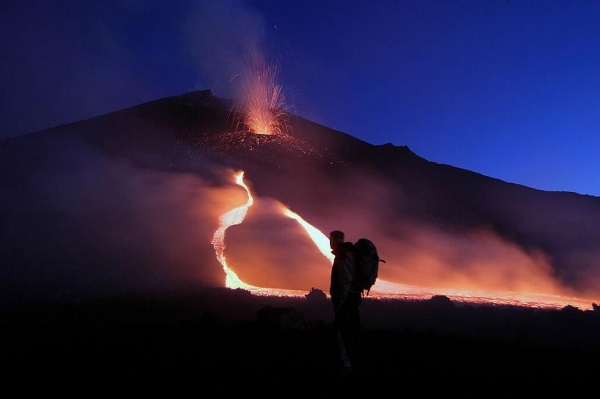
Usually the volcano erupts every three months, and sometimes more often. And once every 150 years, a village lying at its foot is wiped off the face of the earth. but local population does not betray such a phenomenon of particular importance, and continue to grow vegetables, fruits, vineyards, since the soil here is very fertile and suitable for agriculture.
The first eyewitness to the eruption of Etna was the Greek poet Pindar. So, the first eruption was recorded in 485 BC. And since that time, the volcano has shown its activity many times. The longest volcanic eruption was in the 15th century, it lasted about 10 years. In 1991, the last powerful eruption took place, which led to the death of the town of Zafferan.
In 1981, around Mount Etna was created national reserve, which is visited with great pleasure by crowds of tourists. Every day people from all over the world come here to admire the mighty power of the volcano and its incredible beauty. The volcano is especially visible in the morning, and in the afternoon it is covered with fog.
Active volcanoes are the most striking manifestation of the inner activity of our planet, the most interesting objects of geological research and tourist excursions, but also unpredictable sources of danger for people living near them. Volcanoes are also direct sources.
In Russia, the vast majority of volcanic mountains and all active volcanoes are located in the east of the country - on the Kamchatka Peninsula and the Kuril Islands. This territory belongs to the so-called "ring of fire", within which more than 2/3 of the active volcanoes of the planet are concentrated. There is a grandiose tectonic process of interaction between two large ones - the Pacific Ocean and the Sea of Okhotsk. At the same time, the earth's crust, which is older and heavier, sinks (subducts) under the Sea of Okhotsk and, melting at great depths, generates magma chambers that feed the volcanoes of Kamchatka and the Kuriles.
The uniqueness of the landscape of volcanic areas is largely determined by the appearance of young and modern volcanic buildings. These are cone-shaped, often very regular-shaped mountains with a cut off top, where a crater or a larger sinkhole or explosive depression is located - a caldera. All volcanic mountains known in the country are either young - erupted over the past few million years, or modern (), of which only a few are active today.
The question of which volcanoes are considered active is controversial, since the period of rest of many of them can significantly exceed the duration of observation. For example, on the Kamchatka Peninsula, the Bezymyanny volcano before the catastrophic eruption of 1955-1956. did not show activity for more than 1000 years and only conditionally referred to acting. As a result of the study of volcanism in Kamchatka, it was proposed to consider as active volcanoes repeatedly erupting, for which at least one eruption has been historically documented or established by geological methods in the last 3–3.5 thousand years.
The maps show areas of young, mainly volcanism, as well as active volcanoes - active or dormant.
As a rule, it is the volcanoes no older than the Pleistocene volcanoes that have well preserved their forms typical of fire-breathing mountains; often they are associated with post-volcanic processes (fumaroles, hot springs).
Kamchatka-Kuril island arc
The Kamchatka-Kuril island arc with a length of up to 2 thousand km unites the volcanic edifices of the Kamchatka peninsula and Kuril Islands.
The volcanoes of the region are different in structure and composition of products. Klyuchevskaya Sopka, Bezymyanny, Karymskaya Sopka - stratovolcanoes composed of layers of alternating lavas and ash of numerous eruptions; Krasheninnikova, Kikhpinych, Maly Semyachik - volcanic edifices uniting several merged cones-stratovolcanoes; Avachinskaya Sopka - a volcano of the Somma-Vesuvius type; the Kizimen volcano is characterized by extrusive domes (massifs of squeezed out thick lava); the volcanoes Ksudach, Sarychev are crowned with a vast caldera formed by a powerful explosive (explosive) eruption. The volcanoes Klyuchevskaya Sopka, Avachinskaya Sopka, Krasheninnikova, Kikhpinych, Maly Semyachik, Alaid, Chikurachki supply basaltic and basaltic andesite lava to the surface; Karymskaya Sopka and Bezymyanny - andesite; Ksudach, Fussa, Kudryavy - andesite and dacite, with a high content of silica.
The potential danger of eruptions on the Kamchatka Peninsula and the Kuril Islands is associated not only with lava flows. Ashfalls, landslide-explosive phenomena, hot avalanches - streams of loose hot (600-800 ° C) sand and boulders, pyroclastic streams descending from lahara volcanoes - mud-stone streams formed when ice caps melt on tops, threaten the vicinity of volcanoes. Eruptions are usually accompanied, and explosive eruptions of underwater volcanoes are fraught with occurrence.
Currently, about 30 active and more than 160 are known extinct volcanoes... Most often, strong and catastrophic eruptions in the Holocene (over the last 10 thousand years) occurred on two volcanoes - Avachinskaya Sopka and Shiveluch.
Volcano Klyuchevskaya Sopka - the largest active volcano in Eurasia (4 688 m) - is known for its ideal, unusually beautiful cone. For the first time Klyuchevskaya Sopka was described in 1697 by the pioneer of Kamchatka, Vladimir Atlasov. On average, a volcanic eruption occurs once every five years, and in some periods - annually, sometimes for several years, and is accompanied by explosions and ash falls.
The Avachinskaya Sopka volcano, 24-30 km from which the cities and Yelizovo are located, with a population of more than 250 thousand people, is considered one of the most dangerous in the region: over the past 230 years, it has erupted 16 times. Its eruptions are characterized by abundant tephra ejections, extended (up to 17 km) pyroclastic flows and "scorching clouds".
The Ilinskaya Sopka volcano was the center of the largest Holocene eruption (7.7 thousand years ago), during which 140–170 km3 of volcanic material was ejected, which probably led to global climatic changes.
The eruption of the Bezymyanny volcano in 1955–1956. - one of the most powerful and interesting eruptions of the XX century. The summit of the volcano was destroyed by a catastrophic "directed" explosion at an angle of 45 ° to; as a result, a detrital one was formed, the deposits of which destroyed all life on an area of more than 500 square meters. km.
It is more difficult to estimate the number of volcanoes on the Kuril Islands - they are less studied, some of them are underwater. There are up to 104 land-based volcanoes alone, of which about 36 are considered active.
The volcanoes of the Kuril Islands are characterized by eruptions of the most dangerous, explosive type, which are associated with the formation of "scorching clouds", pyroclastic and mud-stone flows. The radius of the zone hit by them can reach 25-30 km. The most potentially dangerous volcanoes are: Mendeleev, Golovnina, Tyatya, Ivan the Terrible, Baransky, Chirip, Chikurachki, Ebeko. The most active volcanoes over the last century were: Sarycheva (7 eruptions), Ebeko (6), Chikurachki (6), Ivan the Terrible (5), Alaid (4). The strongest eruptions in the last century are associated with volcanoes: Raikoke (1924), Severgin (1933), Sarycheva (1946), Alaid (1972, 1981), Tyatya (1973).
Young volcanoes from other regions of Russia
In the recent geological past, volcanism was much more common in Russia. Even in the Pleistocene, and in some places even in the Holocene, volcanism manifested itself in the Greater Caucasus (Elbrus volcano); small volcanoes erupted in the south Eastern Siberia- in the Eastern Sayan Mountains, as well as in Yakutia, Kolyma and the Far East. They are less known, but have typical forms for volcanic structures, composed of lava and ash. Sometimes near them post-volcanic activity is observed - hot mineral springs are gushing, anomalous, etc. These areas are also seismically active.
For the most part, young volcanoes are one of the manifestations of rifting - the process of stretching and splitting, that is, the emergence of new plate boundaries within the continent. Thus, volcanoes in the Eastern Sayan Mountains - in the upper reaches of the Oka River and in the Tunkinskaya depression (I), on the Vitim plateau (II) in the basins of the Vitim, Amalat rivers are associated with stretching crust in the Baikal rift system. The Momsky rift defines the Indigirskaya volcanic region (III). The volcanoes (IV) and Sikhote-Alin (VI, VII) are probably distant “echoes” of the global and long-term process of plate convergence within the “ring of fire”. The volcanism of the Greater Caucasus (VIII) is a manifestation of collision: the collision of two lithospheric plates - the Eurasian and Arabian.
Volcanism is associated with the formation of many deposits of minerals (sulfur, rare metals, etc.), mineral and thermal waters. V last years areas not only of modern volcanism, but also of the young became reserves, natural parks and how unique natural objects attract more and more explorers and tourists.




